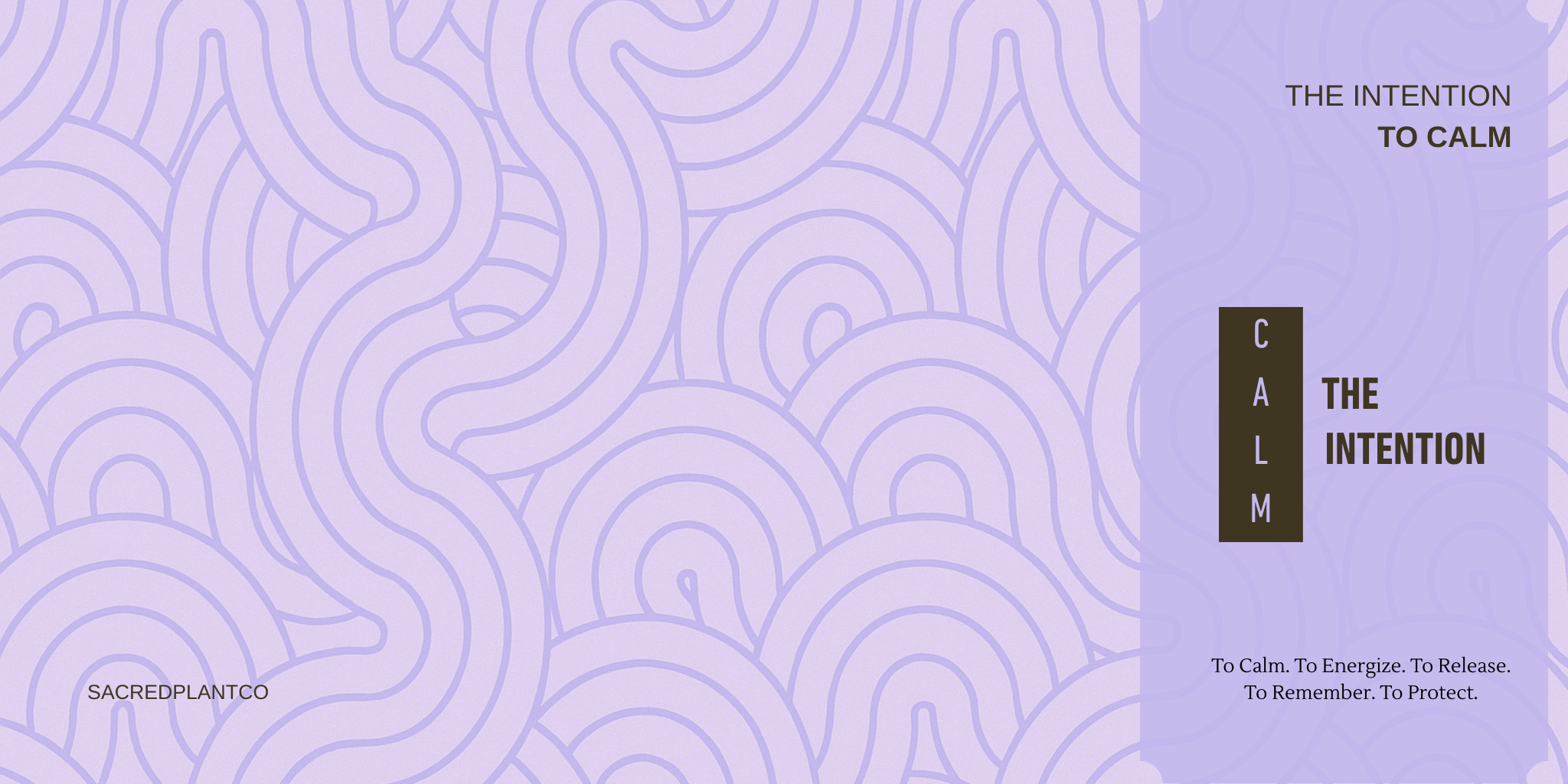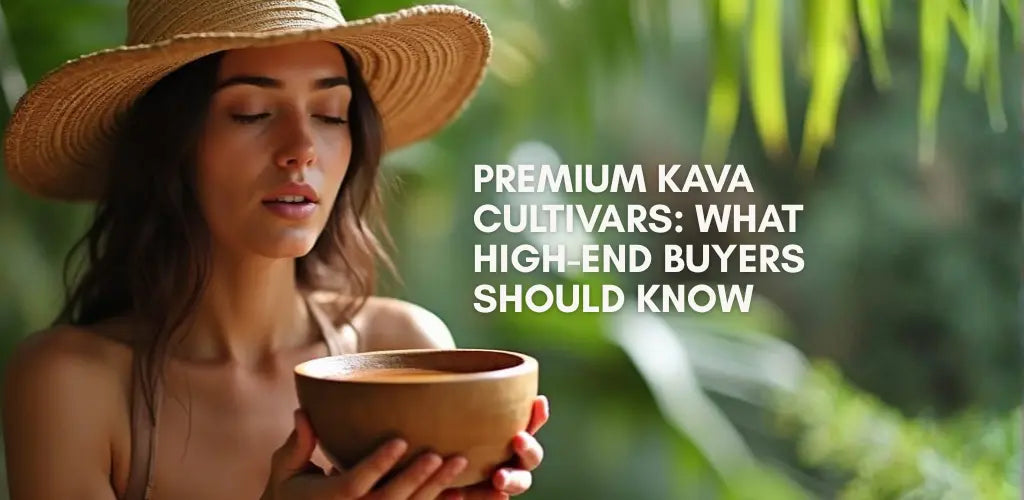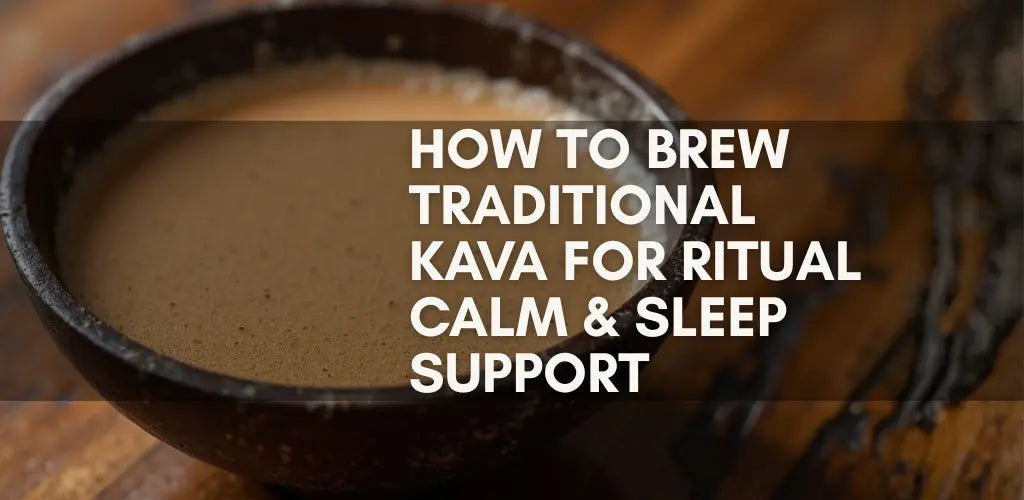Not By Symptom—But By Intention: A Different Way to Choose Your Plant Allies
To calm. To energize. To release. To remember. To protect.
We’ve grown up learning to reach for herbs the way we reach for pills—by symptom. Headache? Take this. Cough? Brew that. But that mindset flattens the soul of herbalism. It treats the plant like a product, not a presence.
There’s another way. A way older than diagnosis and dosage. A way that begins with intention, not ailment.
What if you chose your herb not because of what hurt—but because of what you needed to feel?
What if you brewed tea not to stop a symptom—but to invite a state of being?
To calm. To grieve. To ignite. To open. To fortify.
Herbs, after all, are not just chemical profiles. They are companions. And when chosen by intention, they become ritual, not routine. They become remembrance.
So this isn’t a guide by symptom. It’s a guide by soul-state.
You’re not just treating. You’re aligning.
Let’s begin with the first intention:
To Calm.
To quiet the buzzing. To soften the shoulders. To bring the mind back into the body.
The herbs that help us calm are not sedatives. They are sacred exhalations.
And they remind us that peace isn’t the absence of activity—it’s the presence of stillness, chosen again and again.
Choosing Herbs by Intention: A New Way to Build Your Apothecary

We’ve been taught to think of herbs like medicine cabinets—one for sleep, one for headaches, one for digestion. But before symptom charts and dosage tables, herbalism was something older, deeper, more intuitive.
It was never just about what hurt. It was about what you needed to become.
Herbs were chosen not just for what they did—but for how they helped you feel.
Not to fix—but to align.
Not by symptom—but by intention.
This series is a return to that way. A way of choosing your plants based on purpose. A way of approaching the apothecary like a mirror, not a menu.
We begin with the first intention.
The one we crave when the world is too loud.
When the body forgets how to exhale.
To Calm
To calm is not to sedate.
It is to settle the water without stilling the soul.
It is to bring your breath back from hiding.
It is to hold yourself without bracing.
This is where herbalism begins—not with escape, but with return.
Return to yourself. Return to rhythm. Return to stillness that listens.
In this first chapter, we’ll walk with the herbs that know how to quiet what’s loud, soften what’s rigid, and invite peace where pressure has lived too long.
Because in a world that races, calm is an act of resistance.
How to Choose an Herb When You Don’t Know What You Need
Begin with the intention. Let the plant meet you there.

Sometimes the mind can’t name what it’s feeling. You just know you’re off.
Frayed. Foggy. Heavy.
You stand in front of your apothecary shelf, unsure where to begin. You’re not sick—but you’re not well. You’re not panicking—but you’re vibrating. You don’t want to sedate—you want to soften.
This is when we don’t reach for a symptom—we reach for an intention.
And the first intention is often the most necessary:
To Calm.
But even then, calm isn’t one thing. Do you need to fall asleep? Breathe slower? Cry something out? Come back into your body? Different herbs bring different flavors of calm. And this is where we begin to listen to the plants themselves.
Start with Lavender: When You Need Calm That Clears the Air
If you're unsure, if you're overwhelmed, if the world feels too much—start with Lavender.
Not because it’s popular. Not because it smells pretty.
But because Lavender brings clarity to chaos.
Lavender (Lavandula angustifolia) doesn’t dull the mind—it clears the fog.
It doesn’t sedate—it steadies.
It’s the kind of calm that lets you cry, exhale, feel, and come back to your senses with grace.
Lavender teaches you that peace isn’t the absence of feeling—it’s the ability to hold feeling without drowning in it.
Use it when:
-
You’re stuck in spirals
-
You can’t sleep but you’re not tired
-
Everything feels “off,” but nothing’s exactly wrong
-
You need to feel safe without shutting down
Lavender can be brewed as tea, placed in a sachet near your pillow, massaged into temples with oil, or added to a bath when you need ritual more than routine.
Let this be your compass:
If you don’t know what you need, start with one intention.
If that intention is calm, start with Lavender.
Then listen. The next herb will show up after that.
Passionflower: When Calm Must Untangle the Knots

If Lavender clears the air, Passionflower (Passiflora incarnata) unwinds the wires.
This herb is for when the body refuses to rest. When your thoughts tangle like vines and wrap around your breath. Passionflower is especially helpful for looping thoughts, nervous exhaustion, and circular anxiety that won’t let you drop into sleep or softness.
It doesn’t push. It invites.
It tells the nervous system, you can let go now.
Use Passionflower in:
-
A nighttime tea blend
-
A single-herb tincture before bed
-
Times of grief, insomnia, or long-haul stress
Lemon Balm: When Calm Must Comfort the Heart

There’s a different kind of anxiety—the kind that comes with sadness. That’s where Lemon Balm (Melissa officinalis) shines.
This herb is gentle, bright, and mood-lifting. It’s for when you’re holding too much emotionally and need a plant that hugs back. Lemon Balm works on the heart and gut at once—relieving emotional tension, easing digestive upset from nerves, and calming that fluttery feeling in the chest.
Use Lemon Balm when:
-
You feel low, heavy, or close to tears
-
Anxiety shows up in your belly
-
You need emotional light without feeling stimulated
It’s the herb that reminds you that calm can be sweet, and lightness is a form of strength.
Let the Plants Choose You Back
Start with one. Feel what shifts.
You’re not looking for a cure—you’re listening for a yes.
In this way, herbalism becomes less like solving a problem and more like remembering a relationship.
And when the world goes sideways, the herbs that align with your intention will still show up.
Especially when that intention is to calm.
The Herb Will Help You Choose Peace
Peace isn’t always immediate. It isn’t always obvious.
But when we work with herbs, we’re not forcing peace—we’re inviting it.
Sometimes a client doesn’t know what they need. They just know they’re tense. Tired. Stuck in a rhythm that no longer feels like their own. And often, we as herbalists feel that too.
This is where intention-based herbalism becomes a quiet shift in practice.
We’re not just treating symptoms—we’re facilitating alignment.
When the intention is to calm, the right herb doesn’t impose stillness—it creates the conditions for it. Whether it’s through scent, flavor, warmth, or gentle phytochemical action, the plant helps the body remember a slower rhythm.
-
Lavender softens breath and widens space.
-
Passionflower releases looping thoughts.
-
Lemon Balm brings a mood-lifting lightness without overstimulation.
Each one offers calm in a different language—and each invites peace in a way the nervous system can receive.
This is why plant selection by intention matters. Not because one herb is universally “the best,” but because every herb offers a different pathway to the same inner state.
Let the herb do what it knows how to do.
Let it show you—and your clients—that peace is accessible, even when unreachable by logic alone.
You don’t have to know exactly how to get there.
The plant will help you choose it.
Calm Is a Choice: Let Intention Guide Your Herbal Practice
No one else can define what calm feels like in your body.
Not every formula will fit. Not every herb will resonate.
But intention? That part begins with you.
To choose your own calm is to step out of reaction and into relationship.
With your body. With your rhythm.
With the plants that speak to your version of peace.
Maybe it’s Lavender, helping you clear space.
Maybe it’s Passionflower, helping you let go.
Maybe it’s Lemon Balm, helping you soften into light again.
The right herb for calm isn’t about the strongest sedative. It’s about the one that meets you where you are—and walks with you gently from there.
This is the heart of intentional herbalism.
Not quick fixes. Not rigid protocols.
But quiet partnership—between you and the plant—rooted in trust and presence.
So pause. Listen.
You already have the intention.
Now let the plants help you embody it.
A Ritual for When the World Is Too Loud

You don’t need to escape. You need to return.
This ritual isn’t about disconnecting. It’s about gently reweaving your spirit back into your body—one breath, one leaf, one sip at a time.
What You’ll Need:
-
A quiet corner (indoors or out—wherever silence still lives)
-
One calming herb: Tulsi, Passionflower, Lemon Balm, or Chamomile
-
A small heat-safe bowl or kettle
-
A journal or scrap of paper
-
A cloth or scarf to wrap around your shoulders
The Ritual:
-
Boil the water slowly.
Let the act of boiling water become the start of your ritual. Watch the steam rise. Listen to the slow beginning of bubbles. Don’t rush it. Let time stretch. -
Steep your herb with intention.
Choose one plant. Just one. Hold it in your hand before you brew. Inhale deeply. Whisper to it—not a wish, but a truth:
“I’m here. I’m overwhelmed. I’m ready to come back to myself.”
Pour the water. Cover your cup. Let the steam stay in. -
Wrap yourself in the cloth.
As the tea steeps, drape a scarf, shawl, or cloth around your shoulders. Weight matters. It grounds the nervous system. You are swaddling your spirit in safety. -
Breathe in threes.
Three deep breaths.
Three reasons you’re grateful to be still.
Three things you’re willing to let go of—for now. -
Sip slowly.
This isn’t tea. It’s medicine.
Taste every sip. Let the plant remind your body that it’s safe to slow down. Let it coat your nerves like balm. Let it drop you back into rhythm. -
Write a release.
On paper—no screen, no judgment—write down what’s looping in your head. The thought that won’t let you sleep. The thing you can’t fix. The noise that never stops.
Burn it if you can. Tear it up if you can’t. Let it go in some physical, visible way. Your mind is not meant to carry everything. -
Close with thanks.
To the plant. To yourself. To the moment you created. Speak it out loud:
“I am allowed to be soft. I am allowed to be still. I am allowed to feel peace.”
This is your reminder:
Calm is not luxury. Calm is not weakness.
Calm is the sacred stillpoint in chaos.
And you are allowed to return to it—anytime you need.
Calming Lavender Tea for Clarity and Stillness
For when the mind is crowded, and the body holds more than it can name.
This gentle tea brings Lavender’s clearing calm to the forefront—ideal for emotional tension, mental fatigue, sensory overwhelm, or winding down after an overstimulating day. It soothes without sedating, making it perfect for daytime anxiety or early evening transitions.
Ingredients:
-
1 tsp dried Lavender flowers
-
1 tsp dried Lemon Balm (optional, for a soft mood-lift)
-
½ tsp dried Chamomile (optional, to round out sharpness with sweetness)
-
1 cup hot water (just below boiling)
Instructions:
-
Combine herbs in a heat-safe mug or jar.
-
Pour hot water over the herbs and cover with a lid or plate.
-
Steep for 5–7 minutes to preserve delicate volatile oils.
-
Strain and sip slowly.
How to Use:
-
Enjoy warm in the late afternoon or early evening.
-
Ideal for moments of emotional tension, pre-sleep wind-down, or as a supportive practice during breathwork or journaling.
-
Inhale deeply before sipping—Lavender’s aromatics are part of the medicine.
Why It Works:
Lavender works through both olfactory and internal pathways to promote calm. Its volatile oils gently ease nervous system activation and create space for mental clarity. When paired with Lemon Balm or Chamomile, the result is a nuanced calm—light, centered, and emotionally grounding.
A Daily Ritual for Calm: How to Begin Your Day with Lavender
Calm isn’t just something we reach for in crisis.
It’s something we can cultivate quietly, daily, like a soft rhythm that shapes the tone of our hours before urgency can.
Incorporating calming herbs into your morning or daily routine isn’t about slowing everything down—it’s about setting a steadier frequency for the nervous system to follow throughout the day. It helps build a foundation of peace that’s proactive, not reactive.
Lavender in the Morning
Start the day with Lavender not for sleep—but for clarity. Lavender’s ability to soothe without sedating makes it ideal for early moments when the mind is already racing or the body is holding leftover tension from the night.
Try this gentle daily practice:
-
Brew a simple cup of Lavender and Lemon Balm tea as the kettle warms.
-
While it steeps, take 3 slow breaths and name 1 thing you want to carry into your day (like calm, clarity, or patience).
-
Sip slowly, letting the aroma guide your breath. No phone. No to-do list yet. Just presence.
Optional additions:
-
Add a drop of Lavender tincture under the tongue if tea isn't part of your morning rhythm.
-
Use Lavender hydrosol or essential oil (properly diluted) on your wrists or neck for aromatherapeutic support throughout the day.
Why it matters:
Calm doesn’t just show up when we need it—it’s built in small, repetitive acts of intention. Starting your day with a calming herb like Lavender teaches your nervous system that peace isn’t a pause—it’s a pattern.
Learn More: The Plants That Help You Come Back to Calm
If this path toward intentional herbalism resonates with you—if you've felt the difference between numbing and true calming—you’re not alone. These herbs have helped countless bodies and hearts remember what it feels like to be steady, present, and soft again.
Whether you’re just beginning to work with calming herbs or deepening your apothecary with intention, here are some of our most trusted herbal allies to explore further:
Explore the calming qualities of Lemon Balm and Chamomile in this herbal comparison. Discover which soothing herb best supports your intention—whether you're easing anxiety, softening stress, or seeking restful relaxation.
Discover uplifting herbs that support emotional balance and brighter moods. This guide explores natural plant remedies for elevating your spirit and restoring emotional wellness through gentle, intentional herbal support.
Find calm in the chaos with this guide to the best herbal tinctures for anxiety and stress relief. Explore plant-based remedies that gently support the nervous system and help restore inner peace—naturally.
Each of these herbs offers a different expression of calm—choose the one that speaks to your intention.
The work of calming is sacred. Let the plants show you how.
Begin Where You Are. Let Calm Meet You There.

Calm doesn’t always come easily—but it is always possible.
And it begins, not with a cure, but with a choice:
To breathe. To pause. To listen.
To reach for the plant that reminds you how.
Whether it’s Lavender clearing the fog, Passionflower untangling your thoughts, or Lemon Balm softening your heart, the herbs you choose become more than tools. They become companions in your practice of peace.
This isn’t about fixing. It’s about inviting stillness into your daily rhythm—one cup, one breath, one intention at a time.
Because choosing calm isn’t weakness.
It’s wisdom.
And it’s always yours to return to.





